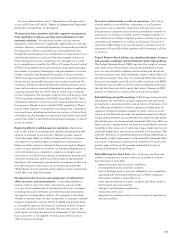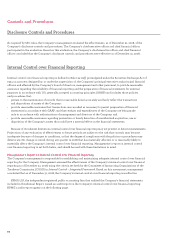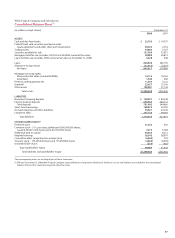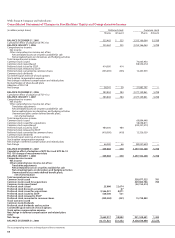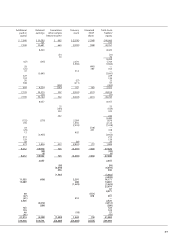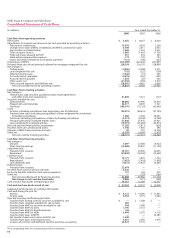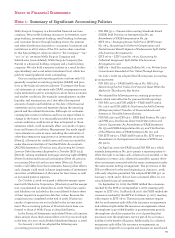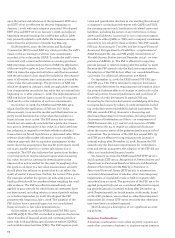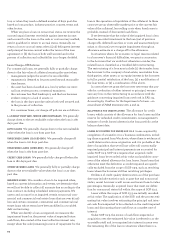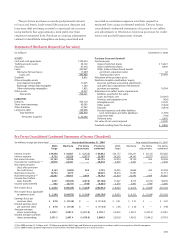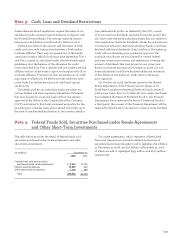Wells Fargo 2008 Annual Report Download - page 95
Download and view the complete annual report
Please find page 95 of the 2008 Wells Fargo annual report below. You can navigate through the pages in the report by either clicking on the pages listed below, or by using the keyword search tool below to find specific information within the annual report.
in one or more other entities that are businesses and obtains
control over those entities. Business combinations may be
effected through the transfer of consideration such as cash,
other financial or nonfinancial assets, debt, or common or
preferred shares. The assets and liabilities of an acquired
entity or business are recorded at their respective fair values
as of the closing date of the merger. Fair values are prelimi-
nary and subject to refinement for up to one year after the
closing date of a merger as information relative to closing
date fair values becomes available. The results of operations
of an acquired entity are included in our consolidated results
from the closing date of the merger, and prior periods are not
restated. All business combinations are accounted for using
the purchase method.
The purchase price of an acquired entity or business, to
the extent the proceeds include our common stock, is based
on the weighted average closing prices of our common stock
for a period two trading days before the announcement and
two trading days after the announcement of the merger,
which includes the announcement date.
To the extent that an acquired entity’s employees hold
stock options, such options are typically converted into our
options at the applicable exchange ratio for the common
stock, and the exercise price is adjusted accordingly. The fair
values of such options are determined using the Black-
Scholes option pricing model with market assumptions. For
vested options, including those that fully vested upon change
in control, the fair value is included as a component of the
purchase price. For options that continue to vest post-merger,
the fair value is amortized in accordance with our policies for
stock-based compensation as described herein.
Certain of the accounting for business combinations as
described herein will change upon the adoption of FAS 141
(revised 2007), Business Combinations, which is effective for
business combinations consummated on or after January 1, 2009.
Consolidation
Our consolidated financial statements include the accounts
of the Parent and our majority-owned subsidiaries and vari-
able interest entities (VIEs) (defined below) in which we are
the primary beneficiary. Significant intercompany accounts
and transactions are eliminated in consolidation. If we own at
least 20% of an entity, we generally account for the invest-
ment using the equity method. If we own less than 20% of an
entity, we generally carry the investment at cost, except mar-
ketable equity securities, which we carry at fair value with
changes in fair value included in other comprehensive
income. Investments accounted for under the equity or cost
method are included in other assets.
We are a variable interest holder in certain special-pur-
pose entities in which equity investors do not have the char-
acteristics of a controlling financial interest or where the
entity does not have enough equity at risk to finance its activ-
ities without additional subordinated financial support from
other parties (referred to as VIEs). Our variable interest aris-
es from contractual, ownership or other monetary interests in
the entity, which change with fluctuations in the entity’s net
asset value. We consolidate a VIE if we are the primary bene-
ficiary, defined as the entity that will absorb a majority of the
entity’s expected losses, receive a majority of the entity’s
expected residual returns, or both.
Trading Assets
Trading assets are primarily securities, including corporate
debt, U.S. government agency obligations and other securi-
ties that we acquire for short-term appreciation or other trad-
ing purposes, and the fair value of derivatives held for cus-
tomer accommodation purposes or proprietary trading.
Trading assets are carried at fair value, with realized and
unrealized gains and losses recorded in noninterest income.
Noninterest income from trading assets was $275 million in
2008 and $544 million in 2007 and 2006.
Securities
SECURITIES AVAILABLE FOR SALE Debt securities that we might
not hold until maturity and marketable equity securities are
classified as securities available for sale and reported at fair
value. Unrealized gains and losses, after applicable taxes, are
reported in cumulative other comprehensive income. Fair
value measurement is based upon quoted prices, if available. If
quoted prices are not available, fair values are measured using
independent pricing models or other model-based valuation
techniques such as the present value of future cash flows,
adjusted for the security’s credit rating, prepayment assump-
tions and other factors such as credit loss assumptions.
We conduct other-than-temporary impairment analysis on
a quarterly basis or more often if a potential loss-triggering
event occurs. We recognize other-than-temporary impair-
ment when it is probable that we will be unable to collect all
amounts due according to the contractual terms of the security
and the fair value of the investment security is less than its
amortized cost. The other-than-temporary impairment loss is
recorded in noninterest income. The initial indicator of other-
than-temporary impairment for both debt and equity securi-
ties is a decline in market value below the amount recorded
for an investment, and the severity and duration of the
decline. In determining whether an impairment is other than
temporary, we consider the length of time and the extent to
which market value has been less than cost, any recent
events specific to the issuer and economic conditions of its
industry, and our ability and intent to hold the investment for
a period of time, including maturity, sufficient to allow for
any anticipated recovery in the fair value of the security.
We hold investments in perpetual preferred securities
(PPS) that are structured in equity form, but have many of the
characteristics of debt instruments, including periodic cash
flows in the form of dividends, call features, ratings that are
similar to debt securities and pricing like long-term callable
bonds. The table on page 104 includes the gross unrealized
losses and fair value of our investments in PPS, by the length
of time they have been in a continuous loss position. Of our
total gross unrealized losses at December 31, 2008, $327 million,
or approximately 3%, related to PPS.


